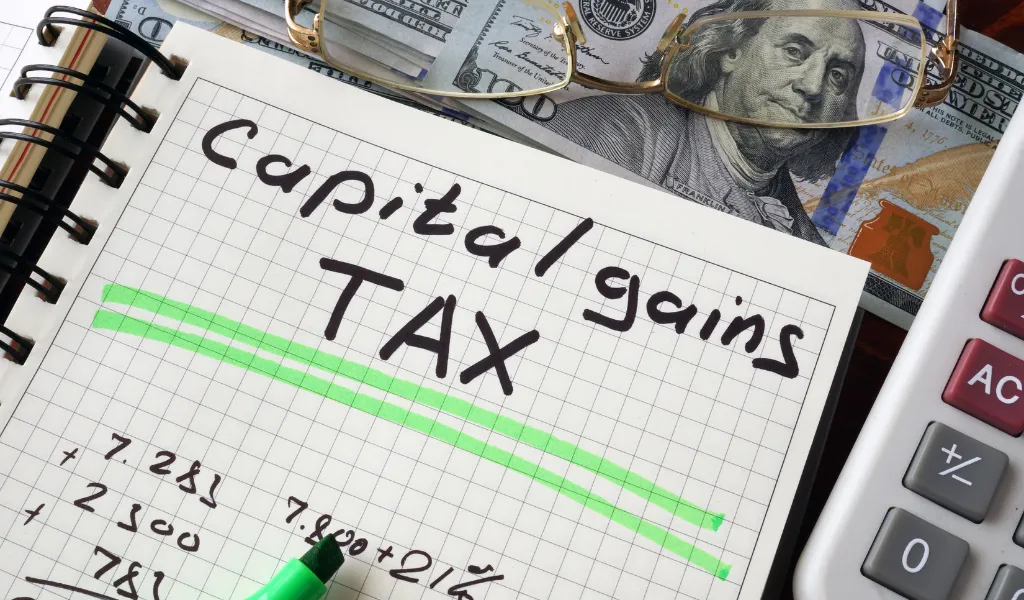In a tax year, you may make a profit on your asset on which you must pay capital gains tax. In certain situations, you may end up making a loss on your asset. If that happens, then the rules are different and more complex. So, what do you do with this loss? This guide will cover everything you need to know about claiming and offsetting capital losses. Furthermore, you will learn if you can offset capital losses against income tax.
First, let us discuss the definition of income tax and its rates. Then, we can move on to capital gains and capital losses.
What is Income Tax?
Based on your annual income, you pay the government tax, which is called income tax. You must pay taxes on the profit you make in case you are self-employed. This is inclusive of any products and services you sell or provide online.
The key source of the government is income tax, which HMRC collects for them. Now, what does the government do with income tax? Well, it uses it to fund public services. For example, education, the welfare system, and the NHS. Additionally, it uses the revenue for other investments as well, which are for public use. Road construction, housing, and railways are just a few such examples.
Who Needs to Pay Income Tax?
Moving on to the question, which incomes are taxable? Most types of income are subject to income tax, such as profit from your business, salary from your job, pension, and the rent you receive as a property owner. Furthermore, estates, corporations, and other kinds of entities also owe taxes on the profits they make.
There is no need to stress, as not all your income is taxable. Fortunately, in most cases, you are eligible for at least one type of tax relief or tax-free allowance. The amount of income you can earn before it becomes liable for income tax is called an allowance. Hence, you should know if you need to report and pay your income tax.
What are the Income Tax Rates for 2024?
The table below shows the current tax rates that apply to your income:
| Income Tax Band | Taxable Income | Tax Rate |
|---|---|---|
| Personal allowance | £0 – £12,570 | 0% |
| Basic rate | £12,571 – £50,270 | 20% |
| Higher rate | £50,271 – £125,140 | 40% |
| Additional rate | Over £125,140 | 45% |
What is Capital Gains Tax?
A tax charge that applies to the gain you make from selling your asset is called Capital Gains Tax (CGT). The calculation of CGT takes place on the profit you make. Which is the increase in the sale’s value price compared to the purchase price. This applies to assets that you hold for more than one year.
Usually, CGT applies to the following:
- Shares.
- Investment funds.
- Sale of a business.
- Second homes.
- Valuables, including jewellery, art, and antiques.
- Inherited properties.
- Assets that you transfer at below their market value.
These assets are currently subject to capital gains tax at rates that differ from income tax rates. This is because investing in such assets is viewed as a risk, whether it be investment-related or entrepreneurial, and so, the potential payoff for taking on further risk is higher. Therefore, it is important to understand how capital gains tax works.
What are the Capital Gains Tax Rates for 2024/25?
It is important to note that CGT rates differ from income tax rates. Two broad brackets exist in the case of CGT. One is of basic rate taxpayers and the other of higher/additional rate taxpayers. For basic rate taxpayers, the CGT rate is 18% on residential property and 10% on other assets. Whereas for higher-rate taxpayers, the CGT rate is 28% on residential property and 20% on other assets.
| Type of Asset | Basic Rate Taxpayer | Higher/Additional Rate Taxpayer |
|---|---|---|
| Residential property | 18% | 28% |
| Shares (not held within an ISA or PEP) | 10% | 20% |
| Other | 10% | 20% |
When Do You Need to Pay CGT?
Whenever you sell a taxable asset and make a gain, Capital Gains Tax will apply. Making a gain means receiving more for the asset than you paid. Nevertheless, there are a few exceptions to CGT.
You must declare CGT on your second home within 60 days of selling it and making a gain.
Furthermore, if you are going to include Capital Gains Tax within your annual tax return, 31 January is the online deadline. Whereas 31 October is the deadline for paper tax.
However, selling a residential property is an exception in this case. Moreover, you should report it within 60 days.
Consequently, you should submit by 31 December in the year after you made gains if you are using the HMRC real-time CGT service to pay. In case there are any cryptocurrency gains, you need to pay CGT on them as well. Hence, you should know when and how to pay CGT.
What is a Capital Loss?
If your organisation or company disposes of or sells a capital asset, it can risk facing a capital loss. In case they sell it at a price that is less than it was worth, then they will not make a profit and suffer a loss instead.
Capital losses differ from trading losses. Therefore, their treatment is also different. You cannot offset them against trading income. However, when it comes to allowable capital allowances, they are set off automatically.
What Happens If You Make a Capital Loss?
Suppose you dispose of an asset. You do so to an unconnected third party and the transaction takes place at arm’s length. Then, even if your annual exemption covers your gains, you need to set any loss against any other gains in the same tax year. As a result, you may end up wasting your annual exempt amount.
After all this, if your losses remain, then you need to inform HMRC. This way, you can use these losses later by carrying them forward. Please note that you cannot carry losses back. There is an exception to this rule. If a taxpayer disposes of an asset in the part of a tax year before passing away, then it is possible. For more information, check out HMRC’s Capital Gains Manual CG30430.
If an asset is exempt from capital gains tax, you cannot claim a loss made on it. Thus, you should know what happens in case you make a capital loss.
Can You Offset Capital Losses Against Income Tax UK?
Unfortunately, you cannot offset capital losses against income tax. However, you can offset them against capital gains in the same year. You need to report your capital losses to HMRC. To carry them forward, you must submit a claim to HMRC within four years of the end of the tax year in which you made the loss. You can carry forward any unused losses indefinitely and offset them against any future gains. If you do not submit a claim within four years, it will be time-barred. Therefore, it is important to understand how to carry forward your capital losses.
Can you Offset the Loss from Share Disposal Against Income Tax?
Nevertheless, if you meet certain conditions, you can reduce your income tax liability through relief for allowable capital losses. What are allowable capital losses? Well, they must arise on a qualifying disposal of shares that you got via subscription in a qualifying trading company.
You must consider the circumstances under which the loss came to rise when you claim relief on a share disposal. Please note that a loss on share disposal needs to have eligibility for capital gains tax loss relief before you can consider whether income tax loss relief can apply to it.
A share disposal can qualify for capital gains tax loss relief in the following scenarios:
- When the disposal is the consequence of an arm’s length sale.
- Where the disposal is a component of a distribution made during the dissolution or winding up of a business.
- When the disposal results from the total loss or destruction of the relevant asset.
- In connection with a negligible value claim.
Moreover, when the loss arises from the reconstruction of a company for capital gains tax purposes, there are limits to relief. Now, you know if you can offset capital losses from the disposal of shares against income tax.
Example
You subscribed £20,000 in 1995 for ordinary shares in a company making tables. The business collapsed in August 2023. As a result, the shares became worthless.
In September 2023, you made a negligible claim for the shares. This claim is for an allowable capital loss of £20,000 for 2023 to 2024 from the deemed disposal of the shares.
If they qualify for share loss relief by meeting all the conditions, you can claim to offset the allowable capital loss on the disposal of shares of your company. You can do so against one of the following:
- Chargeable gains as usual.
- Your income for the relevant year.
- Previous year’s income.
Therefore, there are certain conditions which you must meet to qualify for capital gains tax loss relief.
How Can You Minimise Your Capital Gains Tax Liability?
When saving tax on capital gains, you must consider quite a few things. Please note that it is best to get help from a financial adviser. It is important to know how to reduce your CGT:
Here are ways to reduce your capital gains tax bill:
- By transferring to your partner, you both can benefit from your full pre-tax allowance.
- Using your CGT allowance.
- By declaring any losses to HMRC. They will offset your gains to give a revised contribution amount.
- Selling your principal home. If you meet certain conditions, then you do not need to pay for CGT. This is called Principal Private Residence (PPR) relief. For example, a couple is going through a divorce. One of them is leaving the family home and going to live elsewhere. They are doing so before selling the family home, which is now a secondary home.
- Remaining informed about your wasted assets. These are the assets whose life is less than 50 years. For example, vintage cars, caravans, or antique clocks.
- By investing your money in ISAs or EIS. They both provide a tax-free property for your savings.
- Donating to charity. Income and CGT relief are available if you donate land, property, or shares to charity.
- Contributing to a pension. By doing so, your CGT bracket changes. As a result, you pay less.
- Staying organised. You must know about your taxable assets and your allowance. Also, you should know that how and when you pay CGT affects how much you must pay.
- In case both you and your spouse or civil partner use your annual CGT allowance, the one with the lowest marginal rate of tax should sell the assets.
Thus, there are plenty of methods you can use to reduce your CGT liability.
Conclusion
To summarise, if you are trying to reduce your income tax liability by offsetting capital losses, it is unlikely. Typically, you can carry forward your losses. However, there are certain situations where you can qualify for relief against income tax. This requires your disposal of shares to first meet the conditions. Then, you can offset them against your income tax. Furthermore, there are various ways for you to reduce your capital gain tax liability. Remember, it is always best to speak to an expert and ask them for advice.








